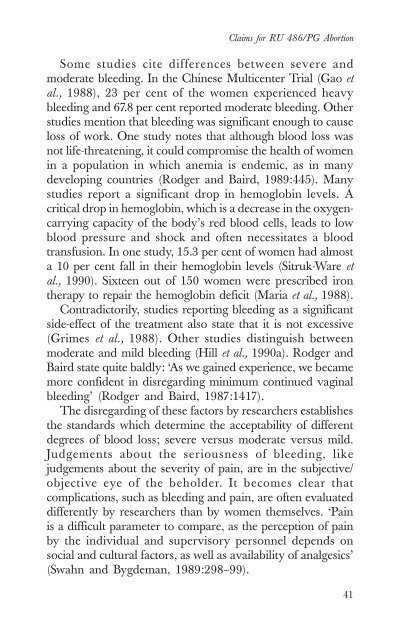Ru 486 Misconceptions Myths and Morals - ressourcesfeministes
Ru 486 Misconceptions Myths and Morals - ressourcesfeministes
Ru 486 Misconceptions Myths and Morals - ressourcesfeministes
- No tags were found...
You also want an ePaper? Increase the reach of your titles
YUMPU automatically turns print PDFs into web optimized ePapers that Google loves.
Claims for RU <strong>486</strong>/PG AbortionSome studies cite differences between severe <strong>and</strong>moderate bleeding. In the Chinese Multicenter Trial (Gao etal., 1988), 23 per cent of the women experienced heavybleeding <strong>and</strong> 67.8 per cent reported moderate bleeding. Otherstudies mention that bleeding was significant enough to causeloss of work. One study notes that although blood loss wasnot life-threatening, it could compromise the health of womenin a population in which anemia is endemic, as in manydeveloping countries (Rodger <strong>and</strong> Baird, 1989:445). Manystudies report a significant drop in hemoglobin levels. Acritical drop in hemoglobin, which is a decrease in the oxygencarryingcapacity of the body’s red blood cells, leads to lowblood pressure <strong>and</strong> shock <strong>and</strong> often necessitates a bloodtransfusion. In one study, 15.3 per cent of women had almosta 10 per cent fall in their hemoglobin levels (Sitruk-Ware etal., 1990). Sixteen out of 150 women were prescribed irontherapy to repair the hemoglobin deficit (Maria et al., 1988).Contradictorily, studies reporting bleeding as a significantside-effect of the treatment also state that it is not excessive(Grimes et al., 1988). Other studies distinguish betweenmoderate <strong>and</strong> mild bleeding (Hill et al., 1990a). Rodger <strong>and</strong>Baird state quite baldly: ‘As we gained experience, we becamemore confident in disregarding minimum continued vaginalbleeding’ (Rodger <strong>and</strong> Baird, 1987:1417).The disregarding of these factors by researchers establishesthe st<strong>and</strong>ards which determine the acceptability of differentdegrees of blood loss; severe versus moderate versus mild.Judgements about the seriousness of bleeding, likejudgements about the severity of pain, are in the subjective/objective eye of the beholder. It becomes clear thatcomplications, such as bleeding <strong>and</strong> pain, are often evaluateddifferently by researchers than by women themselves. ‘Painis a difficult parameter to compare, as the perception of painby the individual <strong>and</strong> supervisory personnel depends onsocial <strong>and</strong> cultural factors, as well as availability of analgesics’(Swahn <strong>and</strong> Bygdeman, 1989:298–99).41
















